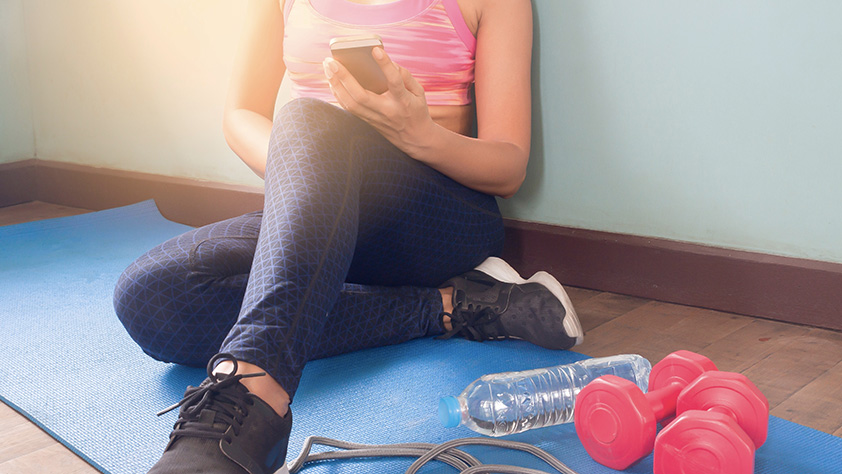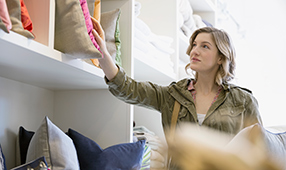As many schools across the country have closed due to coronavirus, members are now working from home, trying to provide continuity in learning for their students. With stress mounting, non-essential locations temporarily suspending business, and entire cities and states on lockdown, it’s still important for educators to maintain their health.
“It’s easy to let your fitness and wellness routines slip when you’re isolated at home, but that’s precisely when you should give them even higher priority,” says Trevor Thieme, CSCS, a personal trainer with Openfit, which offers live online fitness classes, on-demand programs and nutrition advice. “Wellness-promoting activities will not only help ease tension and boost your health during these stressful times, but they will also help to better equip you to care for others that depend on you, including friends, family members and students.”
More than 25 million people already worked out at home before 2020, and that number rose as gyms, yoga studios and other facilities closed to avoid spreading the novel coronavirus. If you’re looking to start or maintain your home fitness routine, see what deals you can find through the NEA Discount Marketplace. Look under the Health & Beauty category, and click on the Fitness & Diet checkbox to make it easy to search for fitness gear retailers, online fitness subscriptions and more.
Home workouts can be as intense as the gym variety. Even though Americans spend more than $3 billion on fitness equipment a year, equipment doesn’t make or break your success.
Mainly, you need to make a commitment to exercise. Finding a regimen that works for you can help you stick with it for the long haul. Many workout routines and virtual classes can actually be done without any equipment, and you can pick a program that suits your current fitness level, exercise preferences, fitness goals, time constraints and equipment availability.
“All you really need is your body weight and about 6 square feet of floor space,” Thieme says, although a few dumbbells and resistance bands are good basics that can help you work more muscles. A pull-up bar, a bench and a yoga mat can round out your collection and broaden your exercise options, he says.
Convenience also is important, especially when you’re already pressed for time. “The most common reason people drop out of exercise is due to time constraints,” says Len Kravitz, Ph.D., coordinator of exercise science at the University of New Mexico in Albuquerque. “Home fitness equipment helps alleviate that issue.”
Starting this habit now can reap benefits later. Once the gyms start reopening, you may even realize you really like working out at home.
Ready to flex your muscles? Consider these tips to help you buy what you need to get set up:
1. Think about what you enjoy doing. Exercise equipment can’t help you shape up if it sits in the corner collecting dust. Choose products based on your workout preferences, says Jessica Matthews, MS, personal trainer and assistant professor of exercise science at Miramar College in San Diego, California. For example, don’t buy a treadmill if the thought of running or walking a lot makes your knees quiver, and avoid a rowing machine if you’re happier doing light cardio.
2. Size up your space. Consider how much physical space you have to devote to exercise, Matthews says. A multi-station strength-training system may require 200 square feet or more, but even treadmills and exercise bikes take up room. Space modification also may be needed: If your garage is sweltering in the summer, it may not be the best place for your treadmill. And if you sweat profusely during workouts, think twice about setting up shop over new carpet without using a rubber mat.
3. Start small. If space and budget are both tight, consider investing in smaller, portable items that are easy to store when not in use. Free weights, exercise balls, resistance bands, workout DVDs and online fitness subscriptions are more practical and less costly than getting an elaborate home gym system, Matthews says. Even walking up and down stairs or lifting gallons of milk can burn calories.
4. Read expert advice and user reviews. Check out product reviews on retailer websites and on health and fitness magazine sites to get an idea of how a product performs long-term and whether it’s likely to help you achieve your goals. Looking to weed out bad options? Type the product or manufacturer’s name along with terms like “complaint” or “problem” into your search engine.
5. Ask around. See if any of your friends or relatives can recommend exercise equipment they like to use. Try calling fitness equipment stores to see if their customer service agents can help you determine what might work well for you. And if you belong to a gym, recall what features you liked about your favorite equipment there.
6. Check the return policy. When you’re ordering equipment online that you haven’t tried out prior to purchase, you want to be sure you can send it back if it doesn’t suit you. Check the retailer’s return policy to see if you’d be able to get a refund or a store credit, and see if there are any fees associated with returning or restocking large items. Other potential hassles when ordering online can include shipping damage and assembly issues, Kravitz notes.
7. Consider used equipment. If you know what you’re looking for, buying used equipment can be a steal. Maybe a retailer is offloading equipment to make room for new merchandise, or a consumer is ditching their treadmill because they’re moving to a smaller space. Either way, look for a 2- to 3-year warranty on moving parts, Kravitz recommends.
8. Safety is key. Machines that move too freely while in motion can lead to injuries. Plus, some manufacturers design products for individuals who are at a healthy weight, which could put someone who is overweight at risk, Kravitz says. Whether you’re shopping for a stationary cycle, elliptical trainer or treadmill, make sure it has an easy-to-reach kill switch.
9. Beware of slick sales ploys. Be skeptical of any machine or product that boasts quick results with little effort and no sweat. Promises that a gadget can blast belly fat or take inches off your thighs are nothing more than snake oil, say experts. When you burn calories by exercising your whole body regularly, you’ll likely see some changes in different areas, including the spots you want to reduce, Kravitz says.
If you’re new to exercise, consult with your doctor if possible to ensure home exercise is safe for you. Do some research online before you start to make sure you’re using your new equipment properly.
“A lot of people ‘overreach’ when picking a workout program,” Thieme says. “It’s common to feel sore when beginning a new workout program, but you shouldn’t always feel sore after you exercise. If you do, it’s a sign that you’re pushing yourself too hard, too fast, too often. Your workouts should leave you feeling challenged and energized, not sore and completely spent.”
When you’re ready to buy, check the NEA Discount Marketplace for member deals on home fitness equipment and more. Plus, you’ll earn cash back while shopping at your favorite stores.












